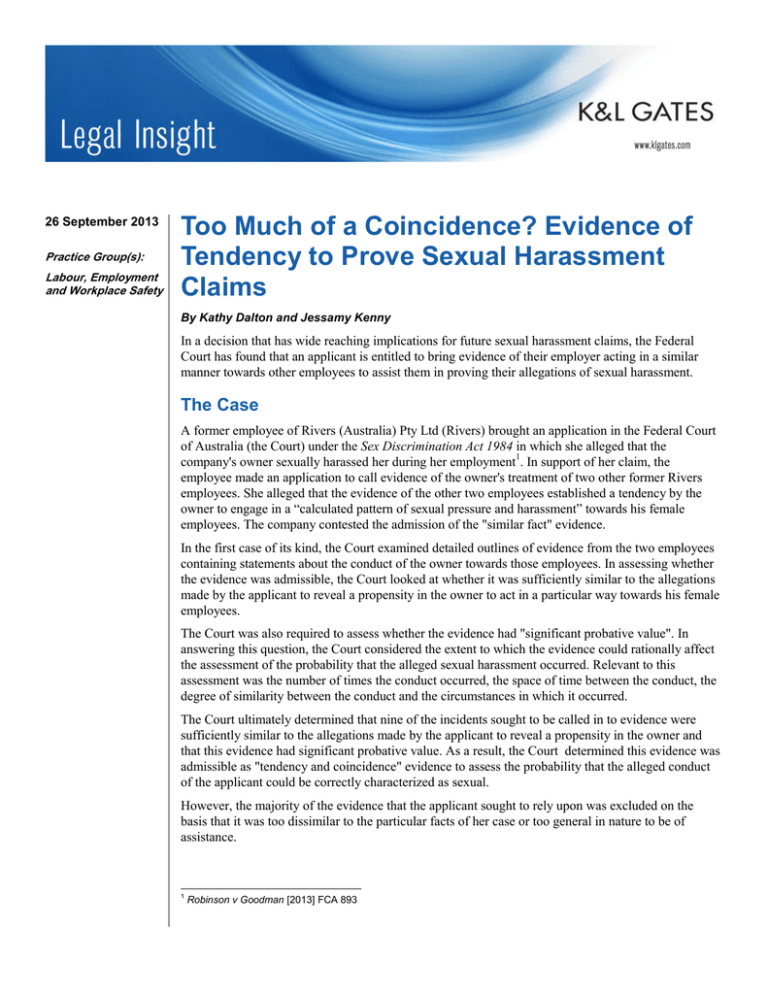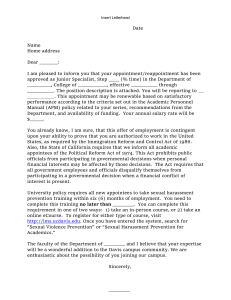
26 September 2013
Practice Group(s):
Labour, Employment
and Workplace Safety
Too Much of a Coincidence? Evidence of
Tendency to Prove Sexual Harassment
Claims
By Kathy Dalton and Jessamy Kenny
In a decision that has wide reaching implications for future sexual harassment claims, the Federal
Court has found that an applicant is entitled to bring evidence of their employer acting in a similar
manner towards other employees to assist them in proving their allegations of sexual harassment.
The Case
A former employee of Rivers (Australia) Pty Ltd (Rivers) brought an application in the Federal Court
of Australia (the Court) under the Sex Discrimination Act 1984 in which she alleged that the
company's owner sexually harassed her during her employment1. In support of her claim, the
employee made an application to call evidence of the owner's treatment of two other former Rivers
employees. She alleged that the evidence of the other two employees established a tendency by the
owner to engage in a “calculated pattern of sexual pressure and harassment” towards his female
employees. The company contested the admission of the "similar fact" evidence.
In the first case of its kind, the Court examined detailed outlines of evidence from the two employees
containing statements about the conduct of the owner towards those employees. In assessing whether
the evidence was admissible, the Court looked at whether it was sufficiently similar to the allegations
made by the applicant to reveal a propensity in the owner to act in a particular way towards his female
employees.
The Court was also required to assess whether the evidence had "significant probative value". In
answering this question, the Court considered the extent to which the evidence could rationally affect
the assessment of the probability that the alleged sexual harassment occurred. Relevant to this
assessment was the number of times the conduct occurred, the space of time between the conduct, the
degree of similarity between the conduct and the circumstances in which it occurred.
The Court ultimately determined that nine of the incidents sought to be called in to evidence were
sufficiently similar to the allegations made by the applicant to reveal a propensity in the owner and
that this evidence had significant probative value. As a result, the Court determined this evidence was
admissible as "tendency and coincidence" evidence to assess the probability that the alleged conduct
of the applicant could be correctly characterized as sexual.
However, the majority of the evidence that the applicant sought to rely upon was excluded on the
basis that it was too dissimilar to the particular facts of her case or too general in nature to be of
assistance.
1
Robinson v Goodman [2013] FCA 893
Too Much of a Coincidence? Evidence of Tendency to
Prove Sexual Harassment Claims
Implications for Employers
The case is significant because the question of whether to admit tendency or similar fact evidence in
civil proceedings of this kind had previously not been considered by the courts.
The ability to rely on this sort of evidence in sexual harassment cases increases the prospect of
complainants undertaking a fishing expedition to uncover other people who have made similar
complaints about a particular employee. For example, complainants may seek discovery of any
previous complaints against their alleged harasser. This gives rise to obvious issues regarding the
privacy of employee records. Further, previous claims may be the subject of a deed of settlement
imposing terms of confidentiality which could be breached by the matters being dredged up in another
complainant's court proceeding.
Importantly, the similar fact evidence need not be with regard to proven complaints or even
complaints that were actually notified to an employer.
Tendency and coincidence evidence may also be relevant in relation to an internal investigation of
allegations of sexual harassment. Where evidence is otherwise in conflict, it may be open to the
investigator to take evidence of similar allegations into account when assessing the probability that the
sexual harassment occurred.
Authors:
Kathy Dalton
kathy.dalton@klgates.com
+61.3.9640.4232
Jessamy Kenny
jessamy.kenny@klgates.com
+61.3.9640.4281
Anchorage Austin Beijing Berlin Boston Brisbane Brussels Charleston Charlotte Chicago Dallas Doha Dubai Fort Worth Frankfurt
Harrisburg Hong Kong Houston London Los Angeles Melbourne Miami Milan Moscow Newark New York Orange County Palo Alto Paris
Perth Pittsburgh Portland Raleigh Research Triangle Park San Diego San Francisco São Paulo Seattle Seoul Shanghai Singapore Spokane
Sydney Taipei Tokyo Warsaw Washington, D.C. Wilmington
K&L Gates practices out of 48 fully integrated offices located in the United States, Asia, Australia, Europe, the
Middle East and South America and represents leading global corporations, growth and middle-market companies,
capital markets participants and entrepreneurs in every major industry group as well as public sector entities,
educational institutions, philanthropic organizations and individuals. For more information about K&L Gates or its
locations, practices and registrations, visit www.klgates.com.
This publication is for informational purposes and does not contain or convey legal advice. The information herein should not be used or relied upon in
regard to any particular facts or circumstances without first consulting a lawyer.
©2013 K&L Gates LLP. All Rights Reserved.
2





